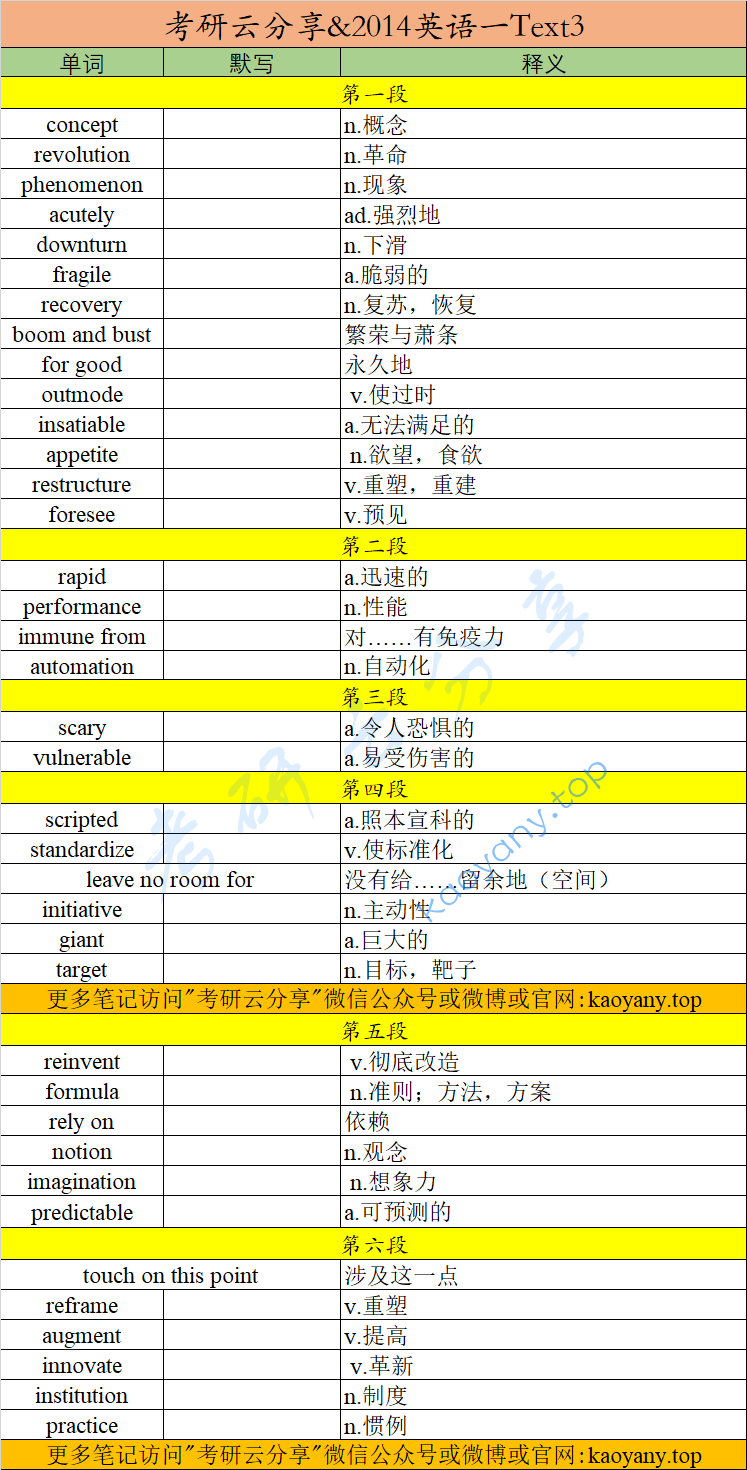第一段
①The concept of man versus machine is at least as old as the industrial revolution, but this phenomenon tends to be most acutely felt during economic downturns and fragile recoveries.②And yet, it would be a mistake to think we are right now simply experiencing the painful side of a boom and bust cycle.③Certain jobs have gone away for good, outmoded by machines.④Since technology has such an insatiable appetite for eating up human jobs, this phenomenon will continue to restructure our economy in ways we cannot immediately foresee.
单词&词组
concept n.概念
revolution n.革命
phenomenon n.现象
acutely ad.强烈地
downturn n.下滑
fragile a.脆弱的
recovery n.复苏,恢复
boom and bust 繁荣与萧条
for good 永久地
outmode v.使过时
insatiable a.无法满足的
appetite n.欲望,食欲
restructure v.重塑,重建
foresee v.预见
本段翻译
“人机矛盾”这一概念至少可以上溯到工业革命时期,但这一现象在经济下滑且复苏乏力的情形下给人的感受最为强烈。然而,那种认为“我们现在仅仅是处于繁荣与萧条循环周期的令人痛苦的一面”的想法是个错误。因使用机器而过时的某些工作已永远地消失了。由于技术在吞噬人类工作方面非常“贪得无厌”,所以这一现象将会继续以难以即时预料的方式重构我们的经济。
第二段
①When there is rapid improvement in the price and performance of technology, jobs that were once thought to be immune from automation suddenly become threatened.②This argument has attracted a lot of attention, via the success of the book Race Against the Machine, by Erik Brynjolfsson and Andrew McAfee, who both hail from MIT's Center for Digital Business.
单词&词组
rapid a.迅速的
performance n.性能
immune from 对……有免疫力
automation n.自动化
本段翻译
当技术在价格、性能方面大为改善时,那些曾经被认为对自动化免疫的工作也就会突然受到威胁。这一观点得益于《与机器赛跑》一书的热卖,已获得广泛关注。该书两位作者埃里克·布伦乔尔森与安德鲁·迈克菲均来自麻省理工学院数字化商业中心。
第三段
①This is a powerful argument, and a scary one.②And yet, John Hagel, author of The Power of Pull and other books, says Brynjolfsson and McAfee miss the reason why these jobs are so vulnerable to technology in the first place.
单词&词组
scary a.令人恐惧的
vulnerable a.易受伤害的
本段翻译
这是个很有说服力,但又让人恐慌的观点。然而,著有《拉动力》和其他书作的约翰·哈格尔认为,布伦乔尔森和迈克菲忽视了这些工作在技术面前不堪一击的根本原因。
第四段
①Hagel says we have designed jobs in the U. S. that tend to be “tightly scripted” and “highly standardized” ones that leave no room for “individual initiative or creativity.”②In short, these are the types of jobs that machines can perform much better at than human beings.③That is how we have put a giant target sign on the backs of American workers, Hagel says.
单词&词组
scripted a.照本宣科的
standardize v.使标准化
leave no room for 没有给……留余地(空间)
initiative n.主动性
giant a.巨大的
target n.目标,靶子
本段翻译
哈格尔说,在美国,我们往往把工作设计成“高度模式化”、“高度标准化”,以至于没给人们留下“发挥个人主动性和创造力”的空间。简言之,这些工作属于“机器可以比人类做得好出许多”的类型。哈格尔说,这就是我们在美国工人背上贴上巨大的攻打标靶的方式。
第五段
①It's time to reinvent the formula for how work is conducted, since we are still relying on a very 20th century notion of work, Hagel says.②In our rapidly changing economy, we more than ever need people in the workplace who can take initiative and exercise their imagination “to respond to unexpected events” .③That is not something machines are good at.④They are designed to perform very predictable activities.
单词&词组
reinvent v.彻底改造
formula n.准则;方法,方案
rely on 依赖
notion n.观念
imagination n.想象力
predictable a.可预测的
本段翻译
哈格尔认为,是时候彻底改造我们的工作模式了,因为我们对工作的认知还停留在20世纪。在经济形势迅速转变的今天,我们比以往任何时候都更需要那些在工作中可以发挥主动性、运用想象力“以应付突发事件”的人才。那是机器所不擅长的事情。它们被设计为执行非常容易预测的行为。
第六段
①As Hagel notes, Brynjolfsson and McAfee indeed touched on this point in their book.②We need to reframe race against the machine as race with the machine.③In other words, we need to look at the ways in which machines can augment human labor rather than replace it.④So then the problem is not really about technology, but rather, “how do we innovate our institutions and our work practices?”
单词&词组
touch on this point 涉及这一点
reframe v.重塑
augment v.提高
innovate v.革新
institution n.制度
practice n.惯例
本段翻译
正如哈格尔所指出的,布伦乔尔森和迈克菲确实在他们书中提到了这一点。我们需要把“与机器赛跑”的概念转换成“与机器同跑”换句话说,我们需要去关注机器“增强”人类劳动力的方式,而不是如何“取代”它。所以这样看来,问题并非真的在于技术本身,而是在于“我们如何革新我们的体制和工作方式”。
五道题
31. According to the first paragraph, economic downturns would ________.
[A] ease the competition of man vs. machine
[B] highlight machines' threat to human jobs
[C] provoke a painful technological revolution
[D] outmode our current economic structure
32. The authors of Race Against the Machine argue that ________.
[A] technology is diminishing man's job opportunities
[B] automation is accelerating technological development
[C] certain jobs will remain intact after automation
[D] man will finally win the race against machine
33. Hagel argues that jobs in the U. S. are often ________.
[A] performed by innovative minds
[B] scripted with an individual style
[C] standardized without a clear target
[D] designed against human creativity
34. According to the last paragraph, Brynjolfsson and McAfee discussed ________.
[A] the predictability of machine behavior in practice
[B] the formula for how work is conducted efficiently
[C] the ways machines replace human labor in modern times
[D] the necessity of human involvement in the workplace
35. Which of the following could be the most appropriate title for the text?
[A] How to Innovate Our Work Practices?
[B] Machines will Replace Human Labor
[C] Can We Win the Race Against Machines?
[D] Economic Downturns Stimulate Innovations
参考答案
BADDC
答案解析
31、根据题干直接定位到第一段。段中指出:人机矛盾可上溯至工业革命时期,但在经济低迷期给人的震撼尤其强烈。[B]选项符合文意。
32、根据题干中的信息关键词Race Against the Machine定位到第二段。该段指出《与机器赛跑》一书观点:当技术在价格、性能方面大为改善时,那些曾被认为不会被自动化所取代的工作会突然受到威胁;潜在含义是,科技使得越来越多的工作被机器取代,[A]选项正确。
33、根据题干中的信息关键词Hagel和jobs in the U.S.定位到第四段。该段首句指出哈格尔看法:在美国,工作被设计成“高度模式化、高度标准化”,以至于人们很少有空间发挥个人主动性和创造力。可见[D]选项正确。
34、根据题干直接定位到最后一段,该段指出哈格尔及布伦乔尔森和迈克菲都赞同的观点:我们应该将“与机器赛跑”重新定义为“与机器同跑”,即:机器是用于加强人类劳动力而不是用于取代人类劳动力。最后作者顺而指出:问题不在于技术本身,而在于我们该如何革新制度(即工作方式)。可见,无论是哈格尔还是布伦乔尔森和迈克菲均肯定人类参与工作的必要性。[D]正确。
35、第一段提出“人机矛盾加剧”问题;第二至四段剖析问题,指出人机矛盾的根源并非在于“技术的进步”,而是在于“现有工作模式的滞后”,最后提出解决方式:改变现有工作模式,变“高度标准化、欠缺创造性”为“强调主动性和创造性”;转变当前观念,变“与机器赛跑”为“与机器同跑”。[C]正确。

- 单词 词组
- 本段翻译
- 单词 词组
- 本段翻译
- 单词 词组
- 本段翻译
- 单词 词组
- 本段翻译
- 单词 词组
- 本段翻译
- 单词 词组
- 本段翻译
- 参考答案
- 答案解析
